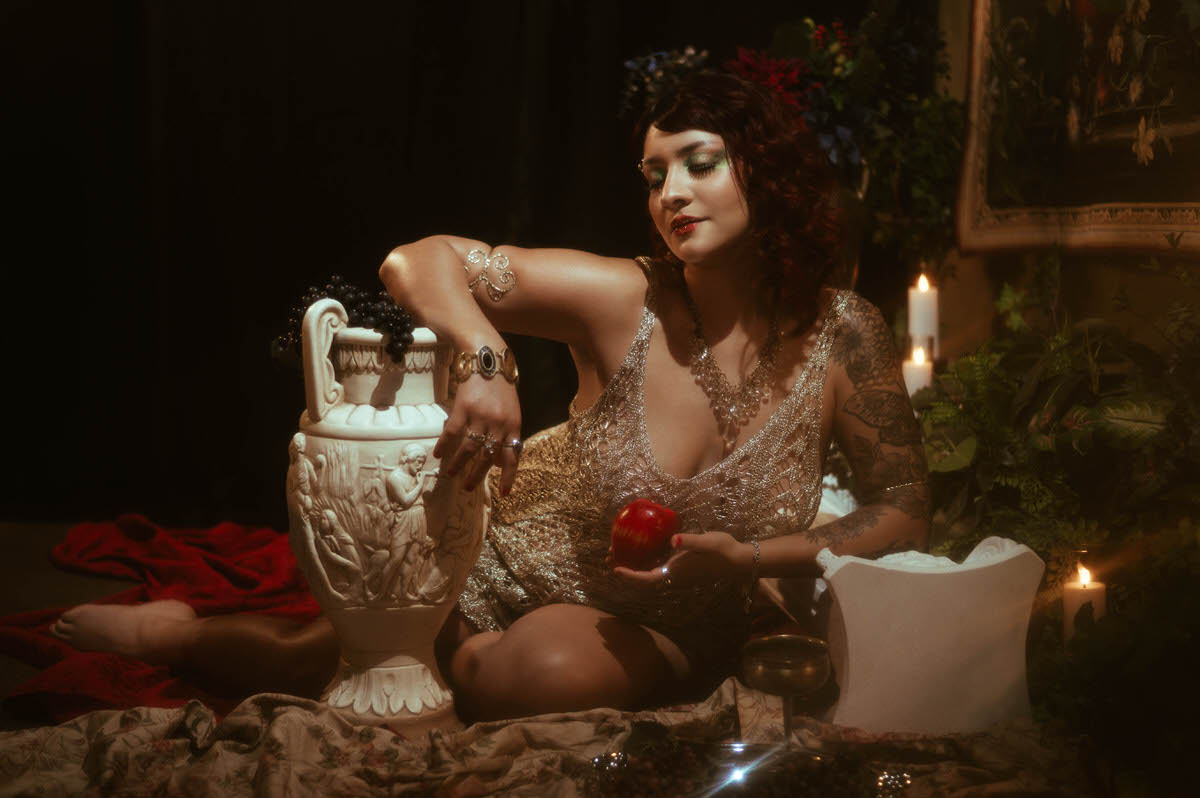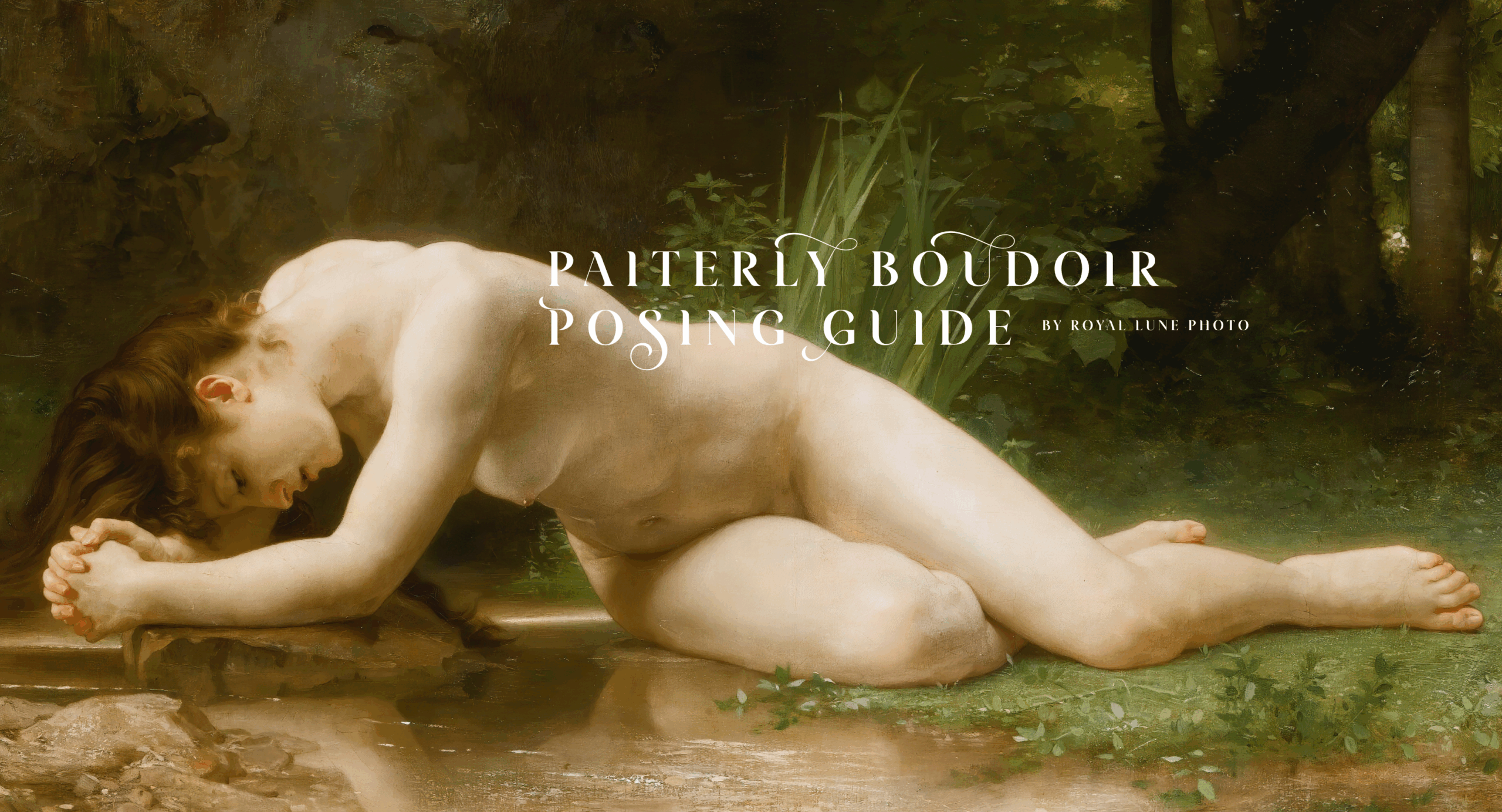July 26, 2025
Becoming a Living Painting: The Painterly Boudoir Posing Guide by Royal Lune Photo
There’s a reason painters throughout history have obsessed over the curve of a hip, the line of a hand, or the tension in a pointing toe. These were never just figures, they were symbols, metaphors, living compositions. As a fine art boudoir photographer, I often find myself channeling that same artistic gaze. In this post, I’m sharing my personal boudoir posing guide rooted in painterly aesthetics, one that honors balance, softness, and storytelling through form.
Whether you’re a client stepping in front of the camera for the first time or a fellow photographer looking for boudoir posing inspiration, this guide is filled with intuitive techniques and artist-inspired prompts that breathe life into each pose.
Back to the Basics: The Art of Posing
While composing the image is the “job” of the photographer, the subject’s posing plays a huge role in the overall composition of the shot. With posing, it’s important to keep some basic principles in mind: balance, connection, and fluidity. This can be seen with how you interact with a prop, the placement of your hands, or even the tilt of your head. In painterly boudoir poses, every gesture and scene is intentional.
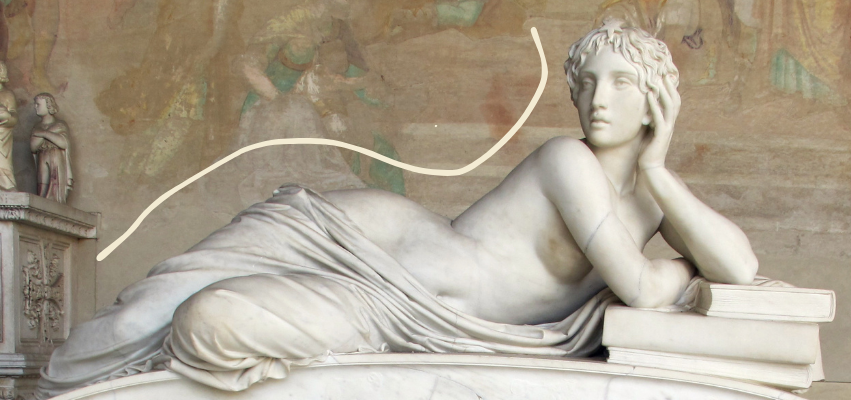
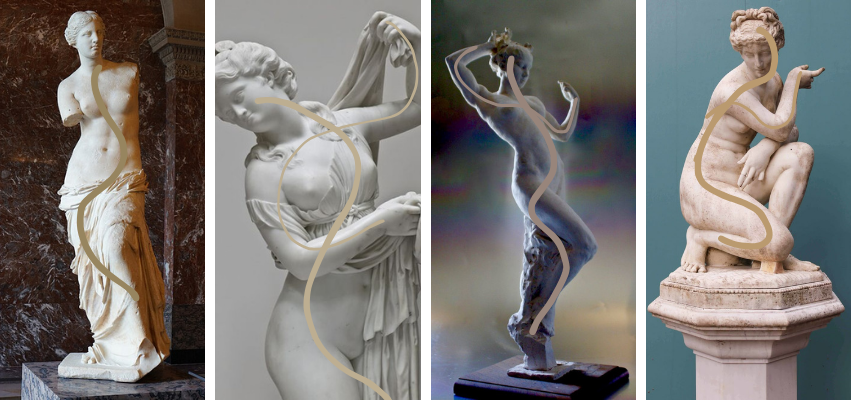
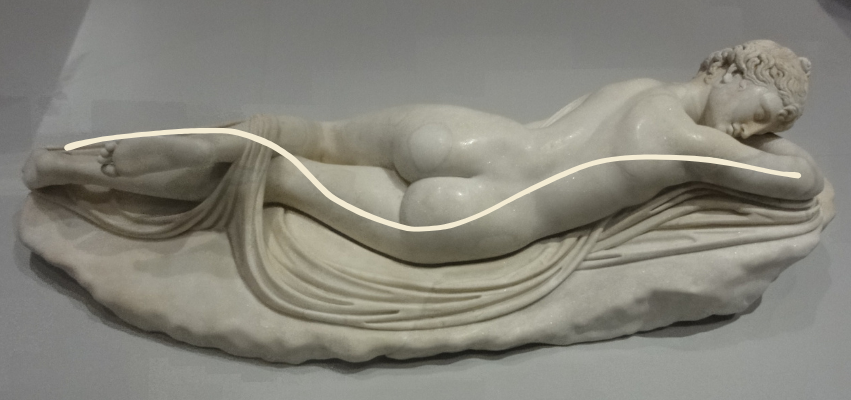
Body Composition in Artistic Boudoir Poses
Referring back to composition, posing your body to create an “S” shape builds the perfect balance and symmetry within a photo. This can be achieved by staggering hand positions, keeping legs together with one knee bent, and twisting your upper half away from your lower half with a gentle arch. The body, in this sense, becomes a series of lines and shapes that lead the viewer’s eye through the image. I oftentimes tell me clients my fine art boudoir photo sessions are a lot like doing yoga, with each pose engaging core muscles, and often involves stretching and twisting your body.
In Renaissance paintings, you’ll often find the figure twisting elegantly – this tension, often referred to as contrapposto, is what gives life to an otherwise static form. Try it in your next pose: relax one hip, shift your weight, and twist ever so slightly. It’s classic art school composition, reimagined for the lens.
Boudoir Posing Ideas: Storytelling through Emotion
A beautiful image is more than a pose – it’s a feeling. Boudoir posing ideas that incorporate emotion will always resonate more deeply than a technically “perfect” pose. Ask yourself, What emotion do I want to convey here? Is it longing? Stillness? Sensuality? Empowerment?
These expressions start internally. Keep your facial muscles relaxed, your brow soft, and allow a gentle breath to part your lips. The slightest shift in emotion will change the energy of the image. Think of it as method acting, inhabit the feeling, and your body will follow.
The Language of Hands in Boudoir Photography
“What do I do with my hands?” is easily the most asked question I hear. But in artistic boudoir poses, the hands are often what makes a portrait feel complete.
Think about how dancers use their hands: soft, weightless, intentional. Slightly separated fingers, a gentle curve in the wrist, and the avoidance of any rigid tension are key. When you aren’t sure how to pose your hands or arms, I always default to bending every joint to create lots of curves. Whether you’re tracing your own collarbone, running fingers through your hair, or reaching toward the light, always imagine you’re painting the air around you.
Hands direct the viewer’s gaze. They can create intrigue, point toward a focal point, or simply add graceful geometry to the frame.
Leading Lines through Posing
One of the oldest composition tricks in art is using leading lines to guide the eye and in boudoir photography, the body itself becomes the line. Whether you’re lying down or standing, pointing your toes can instantly elongate the legs and direct flow through the pose.
This technique also builds a natural rhythm across the image. In painterly boudoir poses, you want to avoid stiffness or abrupt angles. Every joint – ankle, knee, wrist, elbow, should have a slight bend. A pointed toe, especially in a nude or robe-draped portrait, can completely shift the mood from casual to ethereal. I often say to my clients during their boudoir sessions with me, “the goal is to look natural, but nothing in these poses are “natural.” When you look at paintings, the subjects are rarely existing “naturally”, rather they are “doing ordinary activities” in very intentional poses imposed by the painter.
My Essential Painterly Boudoir Poses
Lounging in the Nude
This pose is about softness, surrender, and balance. Reclining in an S-shape, the subject appears like a figure from a neoclassical painting – vulnerable, but empowered. Adding flowers, draped fabric, or sheer textures enhances the painterly feel. The key here is elongation and and an air of stillness.
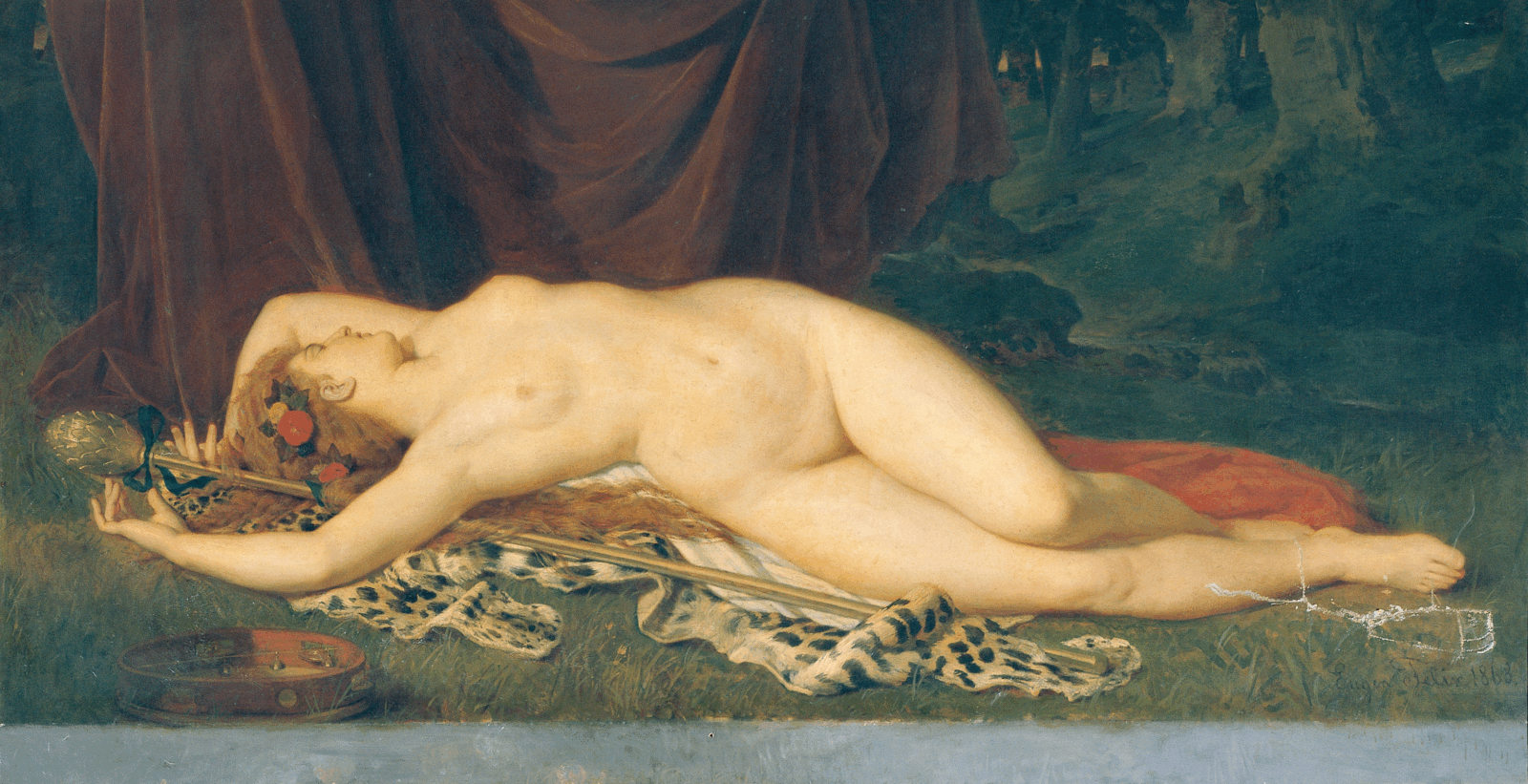
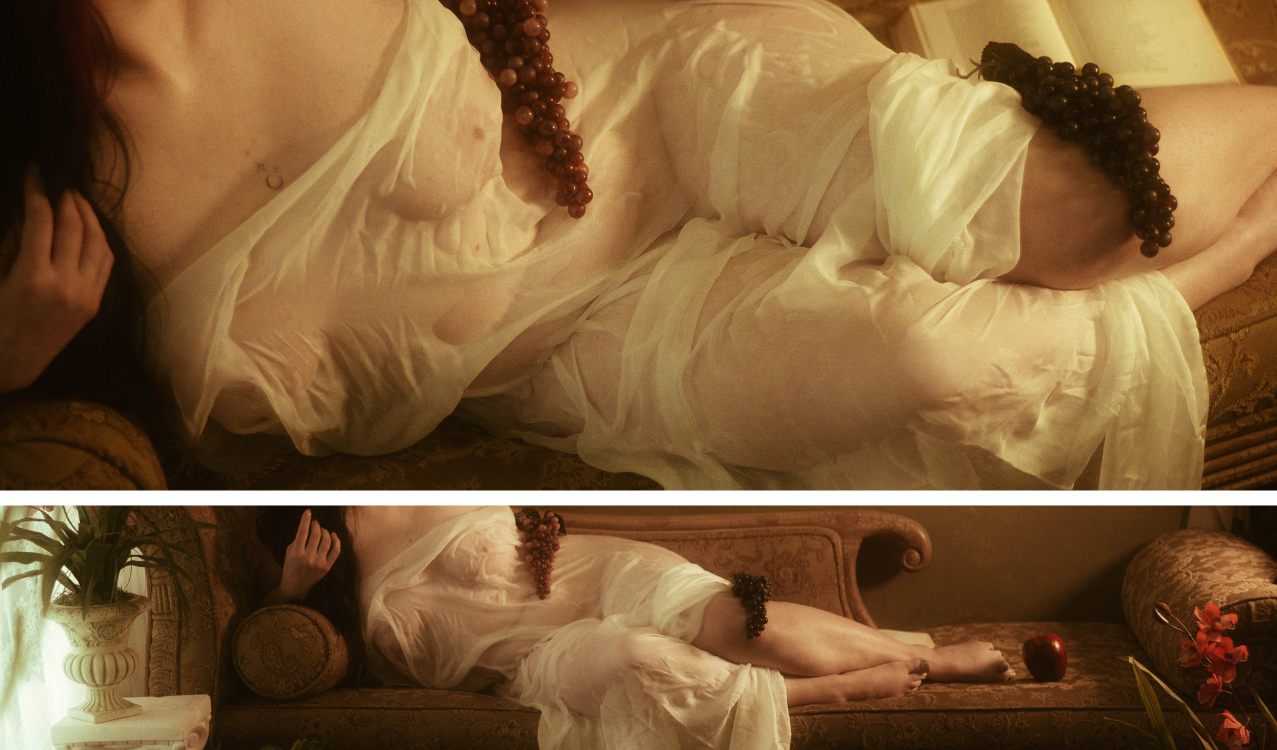
Standing Statuesque
Stand tall, twist the upper and lower halves of your body in opposite directions, and keep your hands relaxed. Place weight on one leg, cross the other slightly forward with a bent knee. Channel a Grecian sculpture by being powerful, yet fluid and graceful.
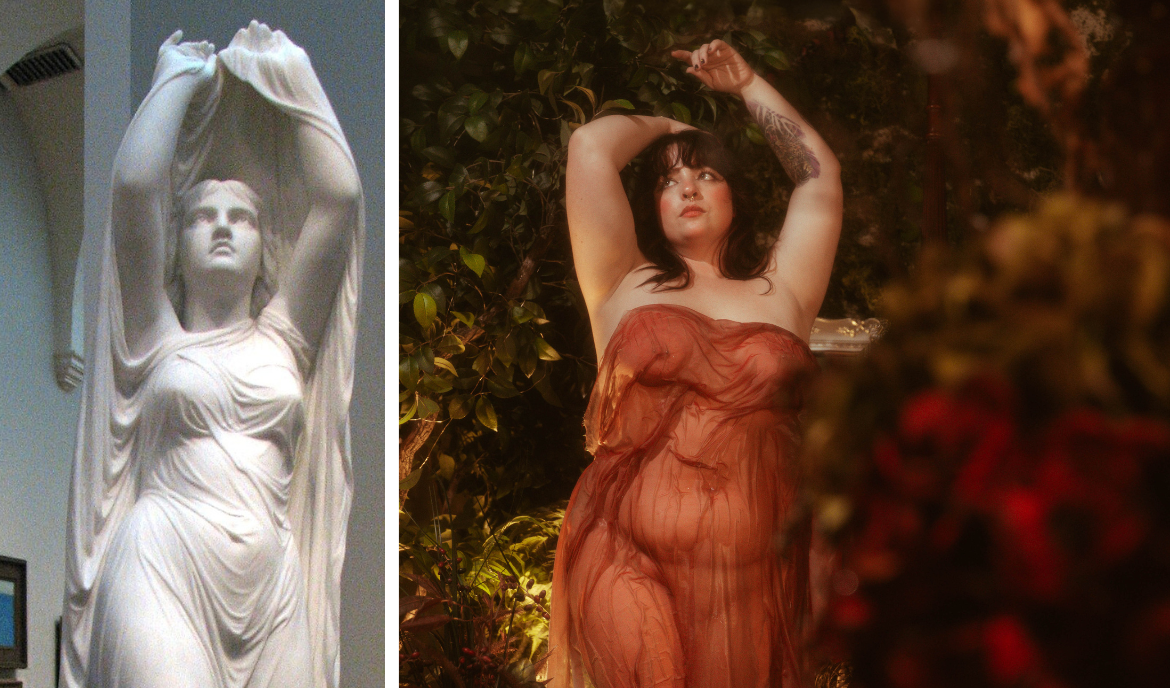
The Art of Emoting
Ask yourself, what emotion do I want to convey? Whether it’s confidence, intensity, sensuality, yearning, sadness – all emotions can be conveyed through body language. Knowing the emotion you want to convey can bring a “good” pose to become a “great” pose. This can be expressed through the eyes, hands, and overall body language.
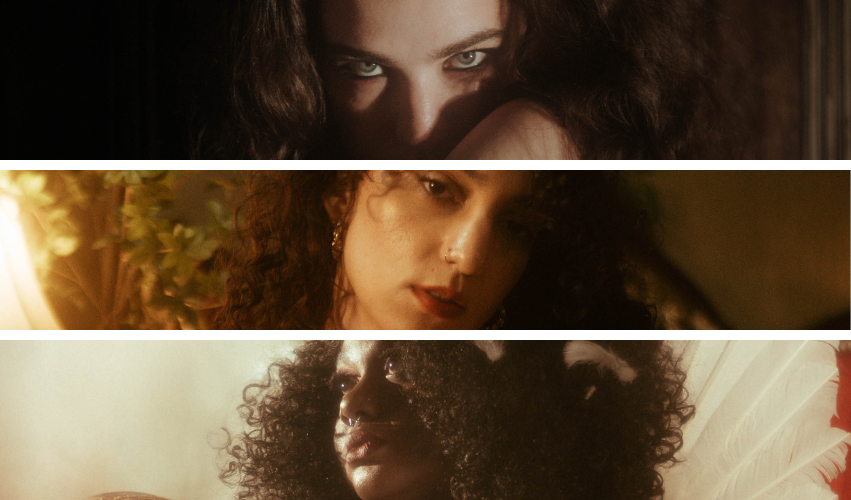
“The Michelangelo”
An outstretched hand, bent softly at the wrist and elbow, mimics the divine reach of Michelangelo’s Adam. This pose draws focus and symbolism, reaching for something unseen. It’s perfect in silhouettes or when combined with dramatic light for a cinematic effect.
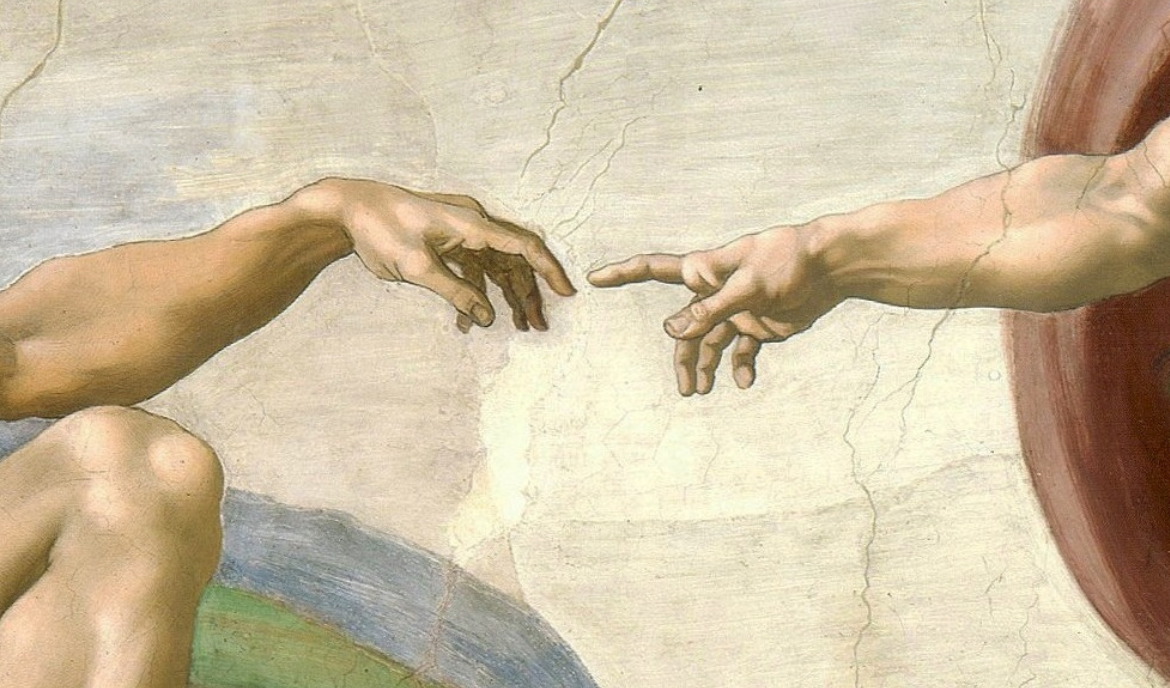
Floating, Translucent Fabrics
Having a dreamy, flowy fabric moment comes down to 2 things: the fineness of the fabric and the flick of your wrist. Materials such as silk, chiffon, and nylon are so fine they seem to float. You’ll notice that the subjects in paintings appear effortless. To achieve this, its important to remember to keep all your joints bent and simply “flick” the fabric while maintaining the original pose. The movement adds softness and drama, mimicking the textures you see in Pre-Raphaelite paintings. This is one of the most iconic artistic boudoir poses for those seeking a fantasy-inspired look.
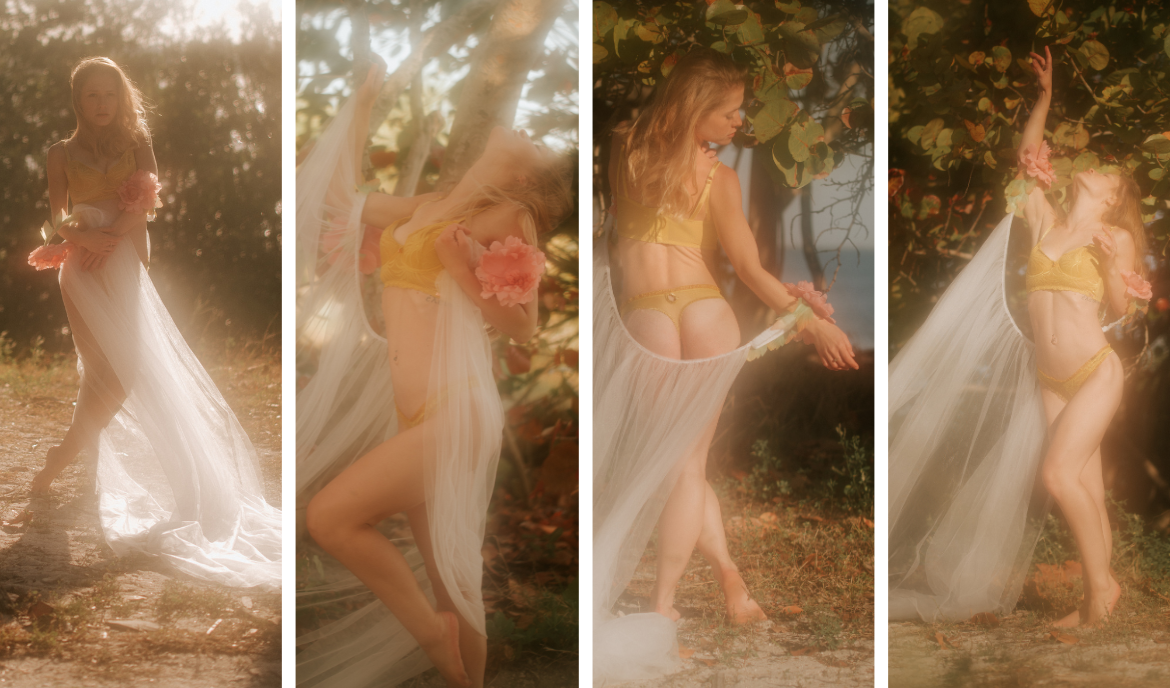
A Soft Zephyr
We all know the term “model hair”. But, how do you get the perfect hair movement on camera? Again, looking effortless is the name of the game. To achieve this, it’s important to keep your face relaxed with your body and hands already in a posed position. Typically, getting the perfect hair flip moment takes a few tries, but when you nail it, it’s magical.
A hair flip not really your jam? No worries, a fan works perfectly for a similar effect. I usually recommend blowing the air from behind or side of my subject for the most drama.
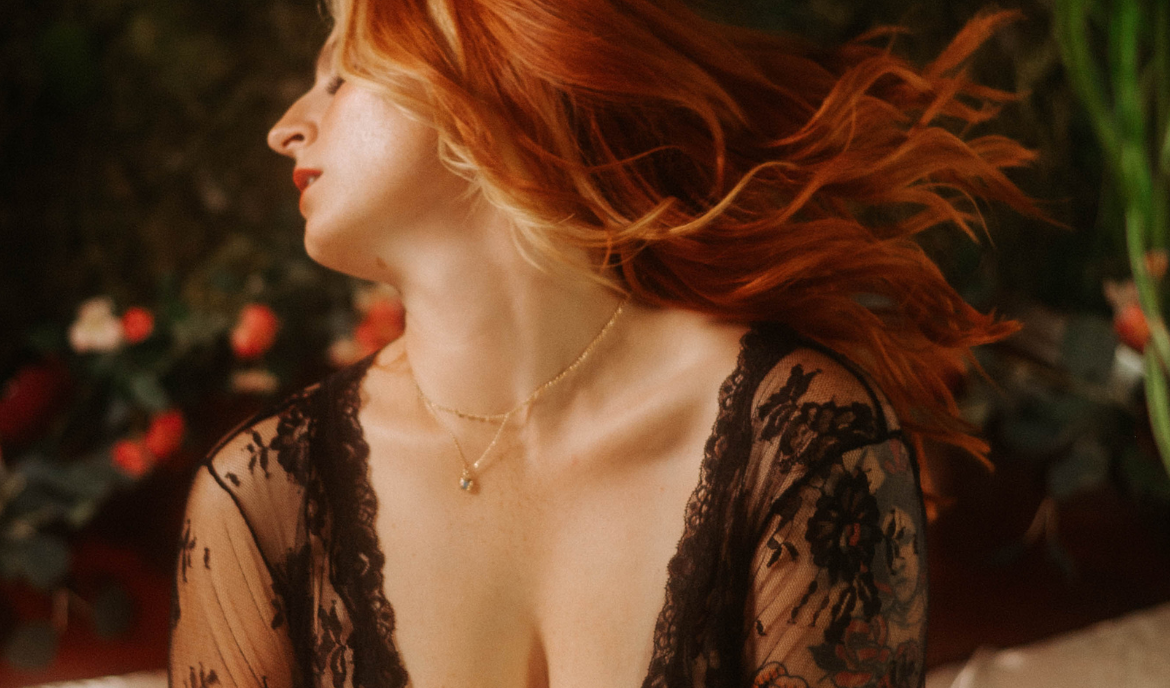
Outdoor Boudoir and Natural Embodiment
Euterria: Becoming one with Nature
In my outdoor boudoir sessions, I always tell clients: Be the wind. Be the trees. Be the water. These sessions are less about posing and more about channeling nature.
Let your arms sway like branches. Close your eyes and breathe as though you’re part of the landscape. Rest your body on moss, leaves, or flowing water like you were born there. These images are not only painterly, they’re poetic. This embodiment is especially powerful when paired with filmic lighting and natural elements like floral crowns, vines, or antique props. It tells a story rooted in earth and femininity.
Not really into the idea of an outdoor boudoir session? Well, since I’ve created my boudoir studio to include lots of nature based elements, I can capture a similar effect in my studio without needing to go outdoors. There is not true substitute for a dreamy outdoor setting, but my studio is the perfect alternative.
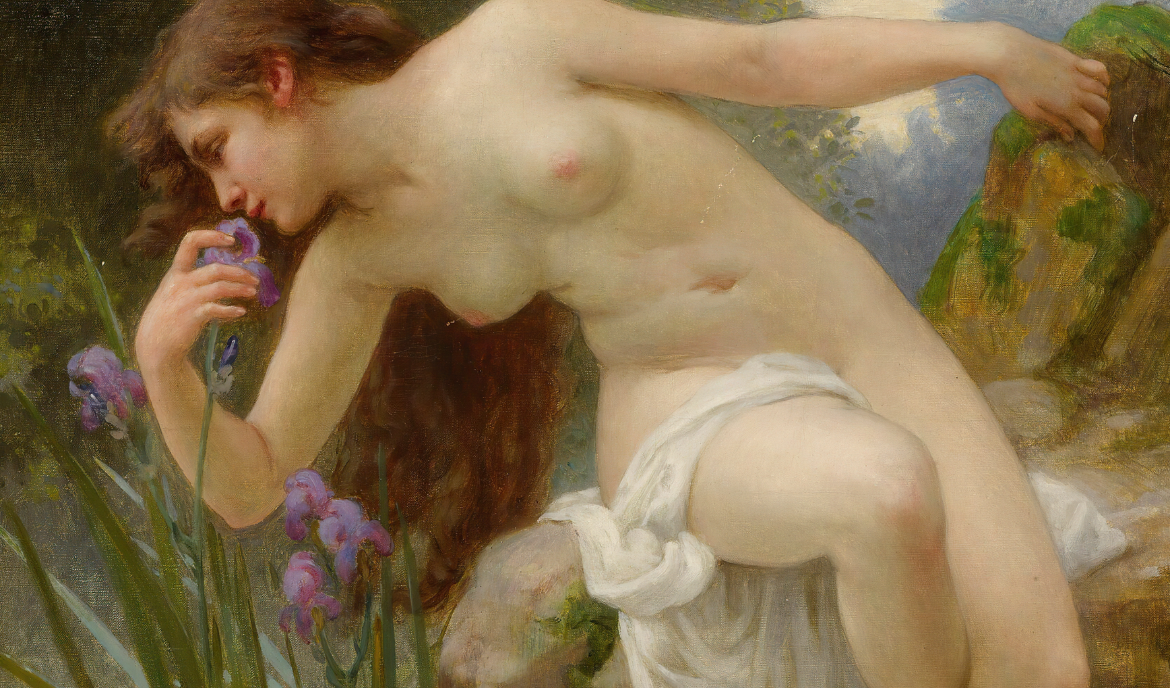
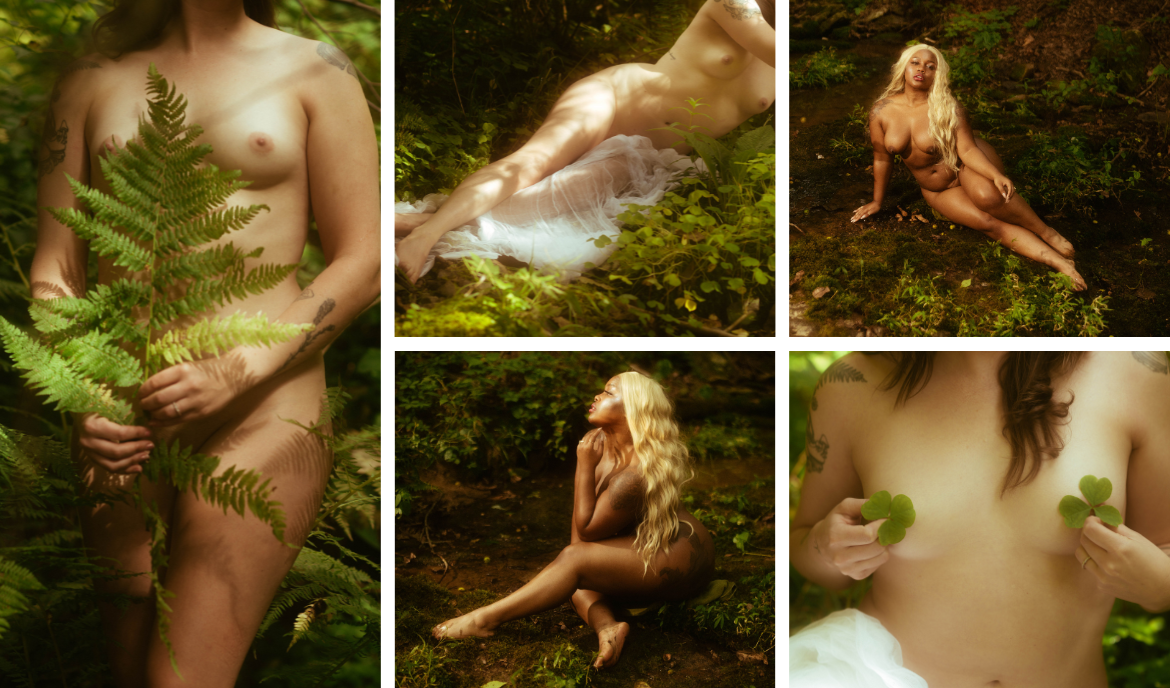
Tips for Clients New to Boudoir Posing
-
Practice in the mirror: Try different angles, hand placements, and facial expressions until you feel connected to your movement. You can put a reference image up on your phone propped up against your mirror and try to replicate the facial expression, body shape, or hand placement. Having a visual makes a huge difference when it comes to learning the basics of posing. For photographers, I always recommend you practice posing in the mirror in order to help clients as needed.
-
Refer to Poses in Paintings: Refer to my mood board or this Instagram account for posing reference inspiration. Just trying to replicate the poses in your own space will help you feel more natural in time for your session. Plus, you can take a stab at taking some cute selfies if you feel up to it.
-
Breathe: The most powerful poses often happen in the exhale, when your guard is down and you’re present in your body.
- Pre-Session Stretches: Doing some stretches or light yoga before your session is a great way to feel less rigid at your sessions. It’s normal to feel nervous beforehand, but doing some stretches will help elevate tension.
-
Trust your photographer: I will guide you every step of the way so there is no need to worry! I often demonstrate poses to my clients as well as providing visual references so you never feel unsure of what to do.
Final Thoughts: The Power of Painterly Posing
Painterly boudoir poses aren’t just about capturing beauty—they’re about celebrating it in all its complexity. They evoke softness, vulnerability, sensuality, and art history all at once. Whether you’re yearning with a hand outstretched or bringing intensity through the eyes, there’s an infinite number of stories your body can tell.
If you’re someone who connects deeply with art, literature, or the romantic beauty of nature, artistic boudoir can feel like an image of the soul.
